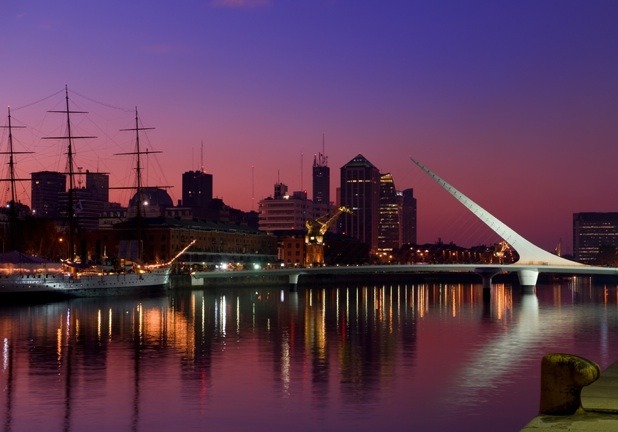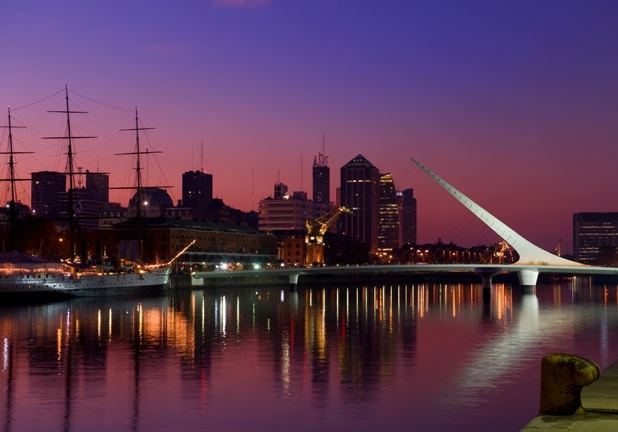A Wine Lover's Tour Of Argentina And Uruguay
Why Argentina? Good question, and it was one that was asked frequently of me before I departed for Latin America. It's a pretty simple proposition really: Argentina is one of a handful of countries where the dollar still goes a long way, it is an easy flight from the U.S. with no effects of jet lag, and in a trip that comprises of a week sandwiched by two weekends you can structure a very balanced itinerary.
Buenos Aires is a lot like New York City. Neighborhoods constantly seem to be reinventing themselves, which is wonderful news because it is one of the finest walking cities in the world. An ideal staring
(Photo courtesy of Veer/pablo hernan)
Next, the original docks and warehouses of the Puerto Madera district now teem with pubs, clubs, wine bars, and restaurants and are a good way to approach the legendary La Boca district. Best reached by cab from Dique 2, this gritty area is known as much for its famous soccer stadium and team as it is for some of the best quality and most reasonably priced food in the city.
This is personified at El Obrero, part soccer shrine and part restaurant that, two trips in a row, served up one of my favorite meals in Buenos Aires. Waiters greet regulars by planting a kiss on the head of a daughter, tousling the hair of a son, and generally giving the impression of an extended family get-together at meal time. Get the restaurant to arrange a cab to nearby El Caminito, if only for a photo opportunity to capture the iconic multi-colored corrugated iron houses. Otherwise this street is a tourist trap. To round out the day, head to San Telmo and stroll its antique store-lined cobbled streets and visit its covered food market.
Swapping the frenetic energy of the city and flying two hours west to Mendoza, I based myself in the wine region for three days of wine tasting — the wine landscape is changing so rapidly that it is
Vines of Mendoza, a soup-to-nuts way for you to be a vineyard owner and winemaker extraordinaire in the Uco Valley. This valley is generating some of the area's best fruit and VoM has bought a large swathe of land, engaged winemaking consultants, and has given rise to a whole generation of vintners. Planting, harvesting, winemaking, bottling... they do it all and you can be as involved as you want. With a resort, cellaring facility, and accommodations under construction it really is safe to say that there is nothing quite like this project anywhere in the Southern Hemisphere.
The second development to put Uco Valley firmly on the map is Clos de los Siete, brainchild of Michel Rolland. Across 2,000 acres of prime land, he has garnered the investment of some heavyweight French wine families who are making wine across five facilities. The wines are as distinct and different as the architectural styles of the respective wineries. Among the most striking is Lindaflor. It seems to rise out of the valley floor, the winery replete with vines planted on its sloping roof, quite mesmerizing.
While it was in the Uco Valley that I really felt the new rush of energy enveloping the Argentinian wine industry, Lujan de Cuyo, the valley to the north of it and closer to the city of Mendoza is more
Cavas Wine Lodge, which may get the nod as most romantic accommodation in a vineyard, globally. The approach to each adobe-style villa is literally through vineyards, but the coup de grace is each private rooftop sleeping terrace complete with fireplace, sleeping bags, and a picture-perfect view of the majestic Andes.
I used it as a base to taste wines at some of the best boutique wineries in the region — many of these wines (or at least the full line up of their portfolio) do not get exported and therein lies the thrill of traveling to the region and discovering them. Producers like Mendel, Bressia, and Pulenta are making malbecs that are velvet and supple, with real aging potential. In addition, there are little gems like the Mendel Semillon (100%). It was labeled as I was buying it and was my favorite white wine of the trip. Another development is the advent of (malbec dominated) blends; the intra-day temperature swings in the region are regularly of a magnitude between 36 and 68 degrees and so the experimentation with different grape varietals in blends is yielding some intriguing results.
This has not gone unnoticed and Paul Hobb's pioneering product, Vina Cobos is arguably producing wines that rival those of his California properties, and when the prices are taken into account, their value proposition is a stand out — almost a no-brainer.
"You have extra time?" is a question enthusiastically asked by many winery staff and what is intended as a perfunctory one-hour visit can rapidly morph into two and a half hours. All enveloping hospitality can easily see you horseback riding through vineyards or enjoying an asado among the vines. That, along with the structured and steady hands behind some of the wines being made, makes this a very worthwhile place to visit. In fact, the best wine harvest festival of its kind south of the equator, Vendimia, takes place in February-March each year and is a once in a lifetime, bucket list type of event: an unconditional celebration and love of wine and all things wine-related.
So, with capital city culture as well as the wine region struck off the list, this leaves 3 days in an itinerary to either head to Patagonia to ski or fish, visit Iguazu Falls or, as I did on this trip, head to Uruguay. A swift one-hour ferry trip from Buenos Aires delivers you to Uruguay's oldest town on the banks of the Rio de la Plata, Colonia del Sacramento. After meandering through the cobbled streets of the old town, across the draw bridge, and to the Basilica, this is a great location for a leisurely lunch. It is a World Heritage Site, and an ideal introduction to the country.
The Four Seasons' most iconic properties (pictured), a haven for horseback riding, mountain biking, and golf. The surprise package here though is Narbona. To visit this little gem of a winery is to take a step back in time. The best way to describe it is to say that the restaurant, panetaria, and the winery evoke the scene from The Godfather II where the family visits the old country to pay homage to their roots and visit a local winery and olive oil farm. As an introduction to the Uruguayan wine industry, you could not hope for more.
The young winemaker, Valeria Chiola, walked me through their lineup, and the aged tannat was excellent. This is a property to keep an eye on as the ubiquitous Michel Rolland has recently signed on to consult.
Leaving Argentina and Uruguay with their heady mix of hearty food, robust wines, and warm hospitality is never easy. The only way to dull the sense of "loss" is to start planning the next trip to this very balanced region... and for me, that means Vendimia 2012. I hope it does for you too.
Report Card:
Favorite Wine: 2004 Mendel "Unus"
Favorite Restaurant: Unik, Palermo Soho
Favorite Accommodation: Cavas Wine Lodge
Most Memorable Moment: Toasting the sunset with a glass of Bonardo atop Cavas villa
(All photos courtesy of Darren Humphries, unless noted.)
Click to learn more about Travel Sommelier's bespoke wine tourism and luxury safaris.

